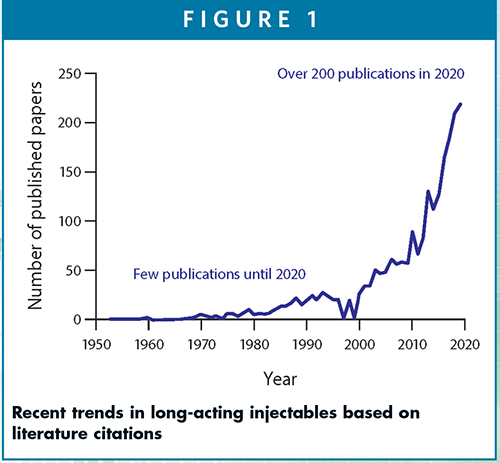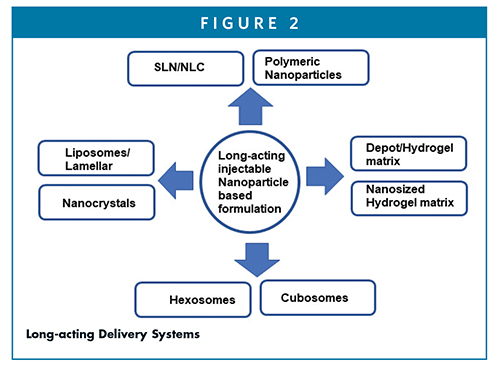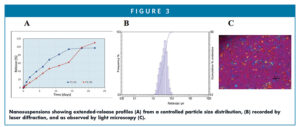Issue:March 2023
FORMULATION FORUM - Changing the Landscape of Nanoparticles for Long-Acting Injectable Drugs
INTRODUCTION
The continued research efforts in areas regarded as long-acting injectables, long-acting parenterals, long-acting depots, depot formulations, sustained-release parenterals, and controlled-release parenterals, have led to an exponential growth in the past two decades (Figure 1).1 Nanoparticles (NPs) play a crucial role in extended-release of long-acting injectable (LAI) formulations. Recently, there has been continued interest in parenteral NPs with sustained-release characteristics as more drugs discovered are poorly soluble and less bioavailable.2 These challenges have led to enormous opportunities and launch of many drug products to market.

The significant growth stems from innovative approaches for developing LAI products that require less-frequent administration for longer and controlled release, and for safety and efficacy of drugs. Less frequent and controlled release equally make LAI more attractive from patient compliance perspectives as one dose can lead to extended release over several weeks and possibly months.3 As nanoparticle technologies continue to yield better and smarter formulations with longer release profiles, the industry is open to adapt more innovative approaches to expedite the process for bringing new drugs to market. The appropriate regulatory guidance on addressing complex molecules, novel excipients, or technologies, for example, could have an impediment in the approval of new drug products.4 Other challenges, such as lack of guidance on test method, validation, manufacturing, particle size reduction, high pressure homogenization, sonication, extrusion, milling, solvent impurities, stabilization, and lyophilization may cause further delays.
Nanoparticles are derived from polymers, lipids, and surfactants/co-surfactants, and oils with unique identities based on the fatty acid characteristics and compositions, polar and non-polar headgroups, and hydrophilic and hydrophobic nature of polymeric chains. The particle size and dispersibility in aqueous solutions depends upon hydrophilic and lipophilic balance (HLB), molecular weight, and polydispersity. The encapsulation and drug loading characteristics are dependent upon drug molecules and interstitial spaces within the polymeric or lipid assemblies. Thus, encapsulation, loading, stability, and efficient delivery might be relevant factors in selecting preferably one technology over the others.
LAIs enable slow and controlled release, slower clearance rate, and resistance to enzymes with longer stability and extended half-life.5 Figure 2 illustrates the long-acting formulations that are categorized as SLN/NLC, polymeric nanoparticles, nanocrystals/nanosuspensions, hydrogels, depots, lamellar assemblies, such as liposomes, cubosomes, and hexosomes, and also into long-acting microneedles and/or implants. Finding the appropriate NP technology for a potential drug candidate depends on multiple factors, most notably the robust design, excipient selection and compatibility, efficient delivery, and long-term stability.

As the interest in LAIs continues to grow, the industry is adapting the innovative technologies and different strategies for launching new drug products. The key strategies are to help increase half-life and retard the release of drug in the systemic circulations to maximize the efficacy. Those strategies may include chemical modifications, PEG-ylation, lipidation, nucleic acid modification from in vivo clearance perspectives, microencapsulation, multi-vascular liposomes, oil-based assemblies, nanocrystals, hydrogels, microneedles, and implants as delivery systems.6
The following will focus on lipid-based and nanocrystal suspension nanoparticles designed for efficient and sustained delivery of drugs.
LONG-ACTING INJECTABLE LIPID-BASED FORMULATIONS
Throughout the years, many drugs have been launched, but only a few are listed in Table 1. Of them, some are designed in liposomes, others in surfactants, polymeric nanoparticles, and nanocrystals for different modalities.

Lipid-based LAIs are oils, aqueous suspensions, and olegels. There are several oil-based LAIs approved in the market, eg, with castor oil (Faslodex®), cotton seed oil (Depo-Testosterone®), sesame oil (Haldol®), and cotton seed oil (Clopixol®), and all are administered intramuscularly (IM). LAI activities of these drugs stem from lipophilic fatty acid derived prodrugs that allow the cleavage of the parent molecule by hydrolysis of ester linkages. While the longer fatty acid slows down the release of drug due to higher partition barrier from oil phase to aqueous phase in an oil-based or suspension-based LAIs, it also runs risk for reducing potency of parent molecules.7 Lipophilicity and higher log P tend to slower release following IM injection, allowing the API uptake predominantly by lymphatic systems.8 In cases in which API is hydrophilic, for example, olanzapine, molecular modification with fatty acid can further reduce the solubility to offset the rapid release, making it ideal for sustained release and uptake by lymphatic systems.9
Other factors, such as viscosity of injectable oils, may have a significant impact on release of drugs. Sesame oil and organogels with higher viscosity and having an excellent tolerability by IM, can lead to slower release and partitioning by diffusion mechanism from oil/gel into body fluid. Suspensions in oil of drug crystals is an alternative oil-based LAI. It is different from the suspensions in aqueous for injection. Oil-based suspensions have limited scope because of difficulty to inject and pain at the injection site; therefore, aqueous-based LAI suspensions are preferred as alternative options than oil-based suspensions. Lipid-based liquid crystal forming systems are another alternative to LAI formulations. The liquid crystalline ability of lipids can provide a controlled-release mechanism by entrapping the drugs into the inner core of the fatty acid lipids. Hence, the sustained release is a result of slower diffusion of drug through the mesophase membrane. There are three mesophases (lamellar, hexagonal, and cubic with hexagonal) that are widely studied.10
In addition, a number of polymeric and lipid-polymer hybrid nanoparticle LIAs have been tested in the preclinical substance use disorders (SUDs) by subcutaneous and intramuscular routes of administration for nicotine and cocaine vaccines.12
NANOCRYSTAL SUSPENSIONS
Throughout the past 2 decades, there has been a continued interest in nanomilling for achieving the desired particle size for controlled release of drugs. The top-down and bottom-up approaches have been generally used to obtain the desired particles to achieve longer release profiles from injections. These approaches suffer with some challenges if the drug is poorly soluble, thus, making the risk factors higher if it requires higher doses. Therefore, the efforts have been focused on liquid long-acting nanosuspensions with solubilizers and anti-flocculating processing aids for higher drug loading, making them more patient compliant and improving the safety profile long-term.
Several drugs have been marketed in nanocrystal suspensions, including the antipsychotic drug Invega Sustena® (paliperidone palmitate), and its prodrug Invega Trinza® (paliperidone palmitate) among others as shown in Table 2.

In preparation, it requires wet milling or high-pressure homogenization, and the resulting LAI nanosuspensions can be lyophilized for improving the longer shelf-life. Figure 3 shows the drug release from nanosuspensions having the particle size distribution range of 100-1000 nm as observed by light microscopy. The extended release of drug lasts for several days from the nanosized crystal suspensions.

- SUMMARY
As we continue to innovate new molecules, the industry is weighing all options and assessing nanoparticle technologies for the development of potential drug candidates. Significant progress, however, has been made in LAIs to meet the clinical needs but is far from over as more challenging molecules continue to be discovered to address the unmet medical needs for treatment of life-threatening aliments and for life cycle management. Dose variability and poor patient compliance pose safety risks, which warrant further assessments of nanoparticle technologies to formulate the new LAI candidates for oncology, antivirals, CNS, and metabolic diseases among other modalities. Thus, there is a continued paradigm shift in the design and development of nanoparticles for injectable drugs. All these challenges point to the fact that LAIs are very promising innovations with great potential to market. Ascendia’s capabilities in solubilization-enabling technologies are relevant in helping the industry working with small and large molecules and biologics and gene delivery. Our expertise in lipid-based LipidSol®, NanoSol®, and EmulSol® formulations and cGMP manufacturing and lyophilization capabilities of injectable drugs, can help provide the tailor-made solutions leading to expedited development of lead candidates from early stage to late stage in the clinics and commercialization of drug products.
REFERENCES
- L. Rahnfeld and P. Luciani, Injectable Lipid-Based Depot Formulations: Where Do We Stand?, Pharmaceutics, 2020, 12, 0567.
- J. Huang and S. Ali, Long acting injectable nanoparticle formulations, Am. Pharm. Rev. (submitted, 2023).
- A. N. Kurnool and P. Tavari, Long acting injectables, J. Pharm. Sci., 2019, 11, 2857-2861.
- F. Selmin, U. M. Musazzi, G. Magri, P. Rocco, F. Cilurzo and P. Minghetti, Drug Discovery Today, 2020, 25, 321-329.
- A. D. AlQahtani, D. O’Connor, A. Domling, and S. K. Goda, Strategies for the production of long acting therapeutics and efficient drug delivery for cancer treatment, Biomed. Pharmacother., 2019, 113, 108750.
- Y. Shi, A. Lu, X. Wang, Z. Belhadj, J. Wang, and Q. Zhang, A review of existing strategies for designing long acting parenteral formulations: Focus on underlying mechanisms and future perspectives, Acta Pharma. Sinica B., 2021, 11, 2396-2415.
- J. F. Remenar, making the leap from daily oral to long acting injectables: lessons from the antipsychotics, Mol. Pharm., 2014, 11, 1739-1749.
- R. W. Kalicharan, P. Schot, H. Vromans, Fundamental understanding of drug absorption from parenteral oil depot, Eur. J. Pharm. Sci., 2016, 83, 19-27.
- L. C. Blumberg, T. A. Zeidan, A. Maddaford, N. C. Warren and P. Hutchison, Novel N-5-(acyloxyalkoxy) carbonyl prodrugs of olanzapine with physicochemical properties for extended-release. RSC Adv. 2013, 3, 16270-16278.
- J. Wilkinson, D. Ajulo, V. Tamburrini, G. Le Gall, K. Kimpe, R. Holm, P. Belton, and S. Qi, Lipid based intramuscular long-acting injectables: Current state of the art, Eur. J. Pharm. Sci., 2022, 178, 106253 1-20. https://doi.org/10.1016/j.ejps.2022.106253.
- M. A. Boushehri, D. Dietrich and A. Lamprecht, Nanotechnology as a platform for the development of injectable parenteral formulations: A comprehensive review of the know-hows and state of the art, Pharmaceutics, 2020, 12, 510.
- V. Kasina, R. J. Mownn, R. Bahal and G. C., Sartor, Nanoparticle delivery systems for substance use disorder, Neuropsychopharmacology, 2022, 47, 1431-1439.
- C. I. Nkanga, A. Fisch, M. Rad-Malekshahi, M. D. Romic, GB. Kittel, T. Ullrich, Clinically established biodegradable long acting injectables: an industry perspective, Ad. Drug Deliv. Rev., 2020, 167, 19-46.

Jim Huang, PhD
Founder & CEO
Ascendia Pharmaceuticals
j.huang@ascendiapharma.com
www.ascendiapharma.com
Dr. Jim Huang is the Founder and CEO of Ascendia Pharmaceuticals, Inc. he earned his PhD in Pharmaceutics from the University of the Sciences in Philadelphia (formerly Philadelphia College of Pharmacy and Sciences) under Joseph B. Schwartz. He has more than 20 years of pharmaceutical experience in preclinical and clinical formulation development, manufacturing, and commercialization of oral and parenteral dosage forms. His research interests are centered on solubility/bioavailability improvement and controlled delivery of poorly water-soluble drugs through nano-based technologies.

Shauket Ali, PhD
Sr. Director, Scientific Affairs & Technical Marketing
Ascendia Pharmaceuticals
shaukat.ali@ascendiapharma.com
www.ascendiapharma.com
Dr. Shaukat Ali joins Ascendia Pharmaceuticals Inc. as Senior Director of Scientific Affairs and Technical Marketing after having worked in the pharma industry for many years. His areas of expertise include lipid chemistry, liposomes, lipid nanoparticles, surfactant-based drug delivery systems, SEDDS/SMEDDS, oral and parenteral, topical and transdermal drug delivery, immediate- and controlled-release formulations. He earned his PhD in Organic Chemistry from the City University of New York and carried out his post-doctoral research in Physical Biochemistry at the University of Minnesota and Cornell University. He has published extensively in scientific journals and is inventor/co-inventor of several US and European patents.
Total Page Views: 5921











